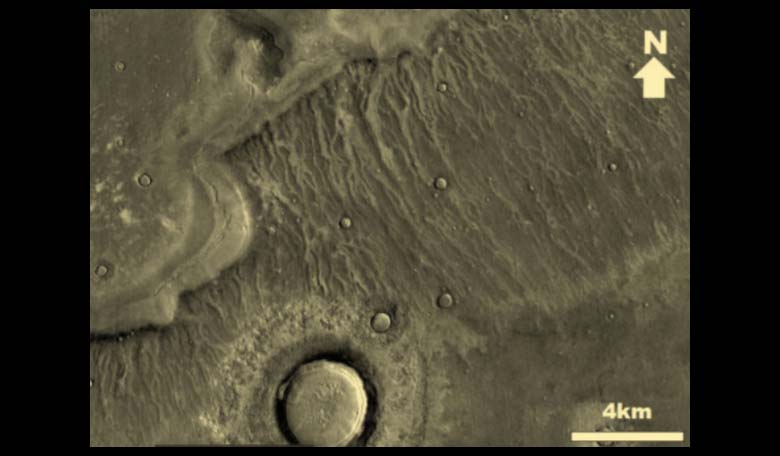Researchers studying geological features on the northern lowlands of Mars that are thought to have once been shorelines, have concluded that these widespread deposits are the result of two mega-tsunamis that resurfaced the planet following the impact of two large meteorites billions of years ago. The teams results correspondingly imply that in order to create these features cold, salty oceans that were perhaps conducive to sustaining life were prevalent on early Mars.
"About 3.4 billion years ago, a big meteorite impact triggered the first tsunami wave. This wave was composed of liquid water. It formed widespread backwash channels to carry the water back to the ocean," said Alberto Fairén, Cornell visiting scientist in astronomy and principal investigator at the Center of Astrobiology, Madrid.
Using a suite of instruments on the Mars Reconnaissance Orbiter, namely the CTX (Context Camera), High Resolution Imaging System Experiment (HiRISE) images and the Mars Orbital Laser Altimeter (MOLA), the team analysed radar-sounding data of the raised deposits, known as the Late Hesperian lowland unit (lHl). Their findings indicate that additional features in the unit represent a period in the martian climate where, in the millions of years between the two meteorite impacts, water turned to ice as temperatures plummeted. "The ocean level receded from its original shoreline to form a secondary shoreline, because the climate had become significantly colder,” explained Fairén.
Because of the ensuing frigid climate, the second tsunami formed rounded lobes of ice that never made it back to the ocean implying that the ocean was at least partially frozen at that time. "Our paper provides very solid evidence for the existence of very cold oceans on early Mars. It is difficult to imagine Californian beaches on ancient Mars, but try to picture the Great Lakes on a particularly cold and long winter, and that could be a more accurate image of water forming seas and oceans on ancient Mars,” said Fairén.
Not only that, but Fairén and his team have suggested that the frozen ancient ocean was possibly briny, as indicated by the rigidity of the ice lobes, which allowed them to retain their well-defined boundaries and their flow-related shapes. "Cold, salty waters may offer a refuge for life in extreme environments, as the salts could help keep the water liquid. ... If life existed on Mars, these icy tsunami lobes are very good candidates to search for biosignatures," said Fairén
Numerical simulations conducted as part of the study show that an impact crater approximately 30 km in diameter would generate tsunami waves with a typical onshore height of around 50 m and local variations from ~10 m to as much as ~120 m. The team estimate that impact craters with a diameter of ~30 km formed at a rate of one every 2.7 million years during the Late Hesperian over the entire ocean’s surface.
The team therefore state that only the largest magnitude tsunami events located at the highest elevations have been observed and although many smaller tsunamis may have occurred, features identifying these events could have been quite literally washed away by larger waves. Nonetheless there are additional signs that could further the teams investigations.
"We have already identified some areas inundated by the tsunamis where the ponded water appears to have emplaced lacustrine sediments, including evaporites," said Alexis Rodriguez of the Planetary Science Institute and co-author of the paper. "As a follow-up investigation we plan to characterise these terrains and assess their potential for future robotic or human in-situ exploration."











